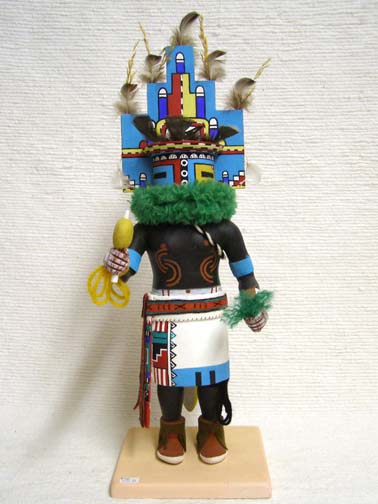If you are interested in Native American culture and are curious about Katsina dolls, you won’t want to miss the Hemis. He plays a vital role in the Hopi tribe and is one of the most well known Katsina dolls. This doll stands above the rest in more ways than one, and it makes a great addition to any collection. Learn about him, where he comes from, and what he represents so that you can decide if this is the next doll for you. His appearance demands attention and inspires the interest of anyone with an eye for Native American heritage and spirituality.
 Appearance
Appearance
One thing you will likely notice is that his appearance is much more vibrant than that of many other dolls in this culture. The compelling appearance is designed to attract attention and highlight everything he represents, and it does its job well. The colorful tablita is the first thing many people notice when they look at the doll, but you will also notice symbols painted in white on his black painted body. The symbols represent friendship.
As far as the designs on the tablita, you will notice phallic symbols for the fertility of the harvest as well as feathers and sheaves of wheat attached to the top of the tablita. Sometimes the Katsina will even carry gifts, which the dancer hands out at Niman (Home-Going) dance. The Hemis is a doll that has a rich history in Native American history, adding to the elegance of this gem.
Performance
Like all dolls of this nature, he is a dancer and performer in Hopi culture. The goal of his dance is to invite abundance, hope and prosperity to the tribe. He has a unique dance and uses his rattles to complete the ritual. Many tribes used his dance to improve their luck and encourage good fortune to rain upon each member of the tribe, representing positive traits and inspiring a positive state of mind. His dance demands attention in ways you might not expect, and he plays a central role in the Hopi religion.
Origin
If you are like many people interested in Native American culture, you are probably wondering about the history and origin of this captivating doll. Understanding the origin of the doll provides insights into its meaning and the values for which it stands. The common belief with the Hopi is this beautiful harvest Katsina originated in the Jemez Pueblo in the Rio Grande area of what is now New Mexico.
Niman
Hemis appears in the Niman ceremony, which is one of the best festival times of the year in Hopi and takes place in July. The tribes looked forward to this time of year because they have said goodbye to winter and spring and now welcome the hot months of summer. During this time, the tribes reap their harvest and feast on the crops they worked hard to cultivate. As part of the celebration, many Katsinam bring gifts to the children as a sign of prosperity and abundance. July is often when the tribe finally gets to enjoy the rewards of their hard work and dedication, which is another reason this doll is essential in their culture.
Final Thoughts
The Hemis is one of the most prominent dolls in Hopi culture because of what it represents. As a symbol of a job well done, its dance comes in July as members of the tribe collect the crops they have grown. The dance of this amazing doll encourages members of the tribe to take a minute to enjoy the rewards of their effort and hard work, and it inspires them to keep moving forward so that they can experience similar rewards in the future. If you would like a positive reminder that good fortune follows hard work and dedication, add this doll to your collection today.
Kachina House has a number of Hemis Katsinam as well as a vast collection of all of the other Katsinam created by the Hopi. These Hopi carved spirit beings are an integral part of Hopi life. We are grateful to the Hopi people for willingly sharing their culture with us.

